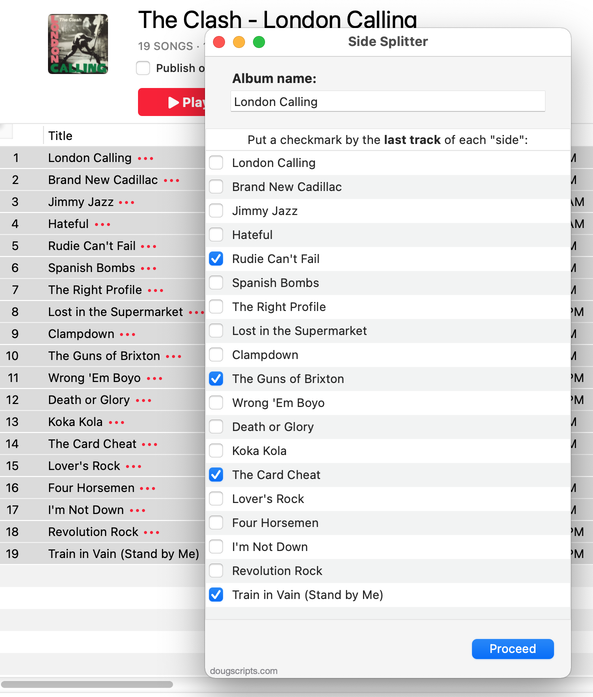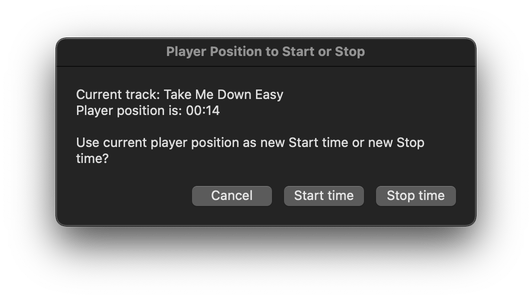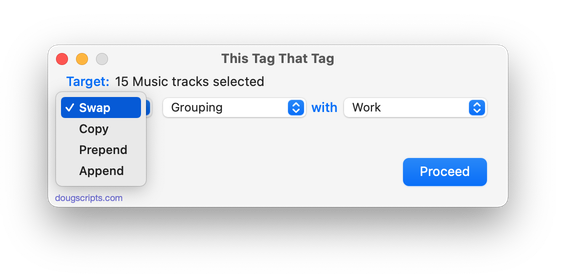UPDATED: List MIAs v5.3
For macOS 10.15 Catalina and later only. This applet checks your Music library for missing and presumed dead tracks--those tracks that Music is unable to associate with a file and which are listed in Music with a "!"--and can delete them from the Music app or create a text file listing these tracks by last known File Path (if available), Song Name, Artist and Album, which you can view using TextEdit.
Also see Super Remove Dead Tracks and Media Folder Files Not Added.
Free to use in Demo Mode: While in Demo Mode, dead tracks will be displayed and can be exported as a list to a text file. Delete from Music and other features will be disabled.
To purchase a registration code and remove these restrictions, download and launch the app. Click "Register..." in its File menu and follow the prompts to purchase a code for $2.99. When your payment is processed, you will be emailed a registration code that will unlock the Demo Mode restrictions.

Latest version:
- Corrects column order in export text
- v5.2:
- Fixes unusual issue when quit
- v5.1:
- Fixes invalid parameter issue some users were seeing that prevented launch
- Additional Catalina accommodations
More information for List MIAs v5.3 and download link is here.
UPDATED: Side Splitter v2.0
For macOS 10.15 Catalina and later only. This script will copy a selection of tracks (presumably the tracks of a single particular album) into separate user-designated "album side" playlists and place these playlists in a distinct Playlist Folder. The script will then play each playlist "side" one at a time, pausing after each one until you accede to play the next "side" (as might occur with an actual LP record).
You can get the track order for an album if you Search Discogs or Search Wikipedia.
Written as a sort of joke to illustrate the awkwardness of recreating an analog music listening experience digitally.

Latest version:
- Accommodations for macOS 10.15 Catalina
- Adds option to "insert" 4 seconds of delay between tracks
- Performance and security enhancements
More information for Side Splitter v2.0 and download link is here.
UPDATED: Year of Release Date to Year v3.0
For macOS 10.15 Catalina and later only. This script will try to grab the year from the Release Date tag of each selected track and copy it to its Year tag. Results are not always fruitful--like, if there is no Release Date tag associated with the track--in which case a track's current Year tag is left unchanged.
FYI: Release Date, like Date Added, is read-only and cannot be altered.
Latest version:
- Accommodations for macOS 10.15 Catalina
- Performance and security enhancements
More information for Year of Release Date to Year v3.0 and download link is here.
UPDATED: Player Position to Start or Stop v3.0
For macOS 10.15 Catalina and later only. Sets the Start or Stop time of the currently paused or playing track to the time of the current player position.
Also seeCopy From Start to Stop and Reset Tracks Start-Stop.

Latest version:
- Accommodations for macOS 10.15 Catalina
- Performance and security enhancements
More information for Player Position to Start or Stop v3.0 and download link is here.
UPDATED: Copy From Start to Stop v3.0
Makes a copy of the selected track using its Start and Stop times as the beginning and ending of the new file and adds to Library, with option to name new track/file. If using with file tracks, NOTE: you may experience some degradation of audio quality if you re-encode a file (one which has already been encoded), and thus the quality of your copy may be a matter of taste. Mileage will vary.
Also see Player Position to Start or Stop and Reset Tracks Start-Stop.
Latest version:
- Accommodations for macOS 10.15 Catalina
- Performance and security enhancements
More information for Copy From Start to Stop v3.0 and download link is here.
UPDATED: Remove From Other Playlists v2.0
This script will remove all replications of the selected tracks (or all the tracks in the selected playlist) from every other user-created playlist (ignoring Smart, Genius and Media Library playlists). The original tracks will not be removed from the selected playlist.
Also see Copy Tracks to Multiple Playlists.
More information for Remove From Other Playlists v 2.0 and download link is here.
UPDATED: Copy Tracks to Multiple Playlists v5.0
For macOS 10.15 Catalina and later only. This script will copy the selected tracks to one or more chosen playlists.
Also see Remove From Other Playlists.

More information for Copy Tracks to Multiple Playlists v 5.0 and download link is here.
UPDATED: Comments Search v2.0
For macOS 10.15 Catalina and later only. This script will search the Comments tags of the Music library tracks for a user-entered text string and copy the track results to a discrete playlist.

More information for Comments Search v 2.0 and download link is here.
UPDATED: This Tag That Tag v5.4
For macOS 10.15 Catalina and later only. This applet will assist with swapping, copying, and appending data between two user-chosen tags in selected tracks or tracks in the selected playlist:
Swap - swap data between tags, ex: ARTISTCOMPOSER
Copy - copy data from one to another tag, ex: ARTIST->COMPOSER ARTIST
Append - append data from one tag to the end of another, ex: ARTIST->COMPOSER - ARTIST
Prepend - append data from one tag to the beginning of another, ex: ARTIST->ARTIST - COMPOSER
The latter three actions also provide an option to delete the info from the first tag after the copy. Read Me explains all.

More information for This Tag That Tag v 5.4 and download link is here.
UPDATED: Re-Apply Downsized Artwork v4.0
For macOS 10.15 Catalina and later only. This applet will examine the artwork of each selected track (or tracks in the selected playlist) and if greater than a user-set resolution (n x n pixels) will downscale the image to that resolution. Artwork already at the set resolution or smaller will not be affected. Includes options to pad image to make square, preserve extant track artworks, adjust preview proportionally and export displayed artwork to disk.

More information for Re-Apply Downsized Artwork v 4.0 and download link is here.
